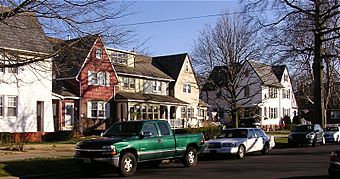Harriman Historic District facts for kids
Quick facts for kids |
|
|
Harriman Historic District
|
|

Harriman district in Bristol, Pennsylvania.
|
|
| Location | Bristol, PA |
|---|---|
| Nearest city | Philadelphia |
| Area | 17 acres (6.9 ha) |
| Built | 1907–1921 |
| Architect | Fred T. Ley Company, Inc. |
| Architectural style | Colonial Revival, Tudorbethan |
| NRHP reference No. | 87000673 |
| Added to NRHP | April 30, 1987 |
The Harriman Historic District is a special neighborhood in Bristol, Pennsylvania, United States. It covers about 17 acres and has 109 buildings. Most of these buildings are houses, along with the local high school.
This area was built between 1907 and 1921. Many of the houses were put up for sale after World War I. Most of these original homes are still standing today. In 1987, the Harriman Historic District was added to the National Register of Historic Places. This means it is recognized as an important place in American history. It's a great example of a neighborhood that the government planned and paid for during World War I.
Contents
What Does the Harriman District Look Like?
The Harriman Historic District has a slightly oval shape. It is bordered by East and West Circle, Farragut Avenue, and Trenton Avenue. Out of the 109 buildings here, 104 are considered important to the district's history.
When the neighborhood was designed, the builders wanted each house to feel unique. Most homes are built in the Tudor Revival or Colonial Revival styles. They often have brick on the first floor and stucco or wood on the second. Many also feature large porches and steeply sloped roofs. The only major non-residential building still standing is the Bristol Junior/Senior High School. It was originally built as the Harriman Public School.
About 100 of the first buildings are still here. However, many original non-residential buildings, like the hotel and restaurant, were torn down. This made space for more homes. The streets in the district are wide and lined with trees. Many are named after American Presidents.
You can also find six rows of older company houses built in 1907. These were for workers of a different company that Harriman later bought. These older houses look very similar to each other. This is a big difference from the unique homes built by the Emergency Fleet Corporation (EFC).
How the Harriman District Was Built
In 1917, a wealthy businessman named W. Averell Harriman started the Merchant Shipbuilding Corporation (MSC). He expected the United States to join World War I soon. His goal was to build merchant ships for the war effort. Harriman first bought an old shipyard in Chester, Pennsylvania. He also bought land in Bristol, where he planned to build a more modern shipyard.
After the U.S. entered the war, Harriman made a deal with the Emergency Fleet Corporation (EFC). The EFC agreed to build the Bristol shipyard and rent it from MSC. In return, MSC would build forty large freighters (cargo ships) at the yard. The first parts of the ships were laid down in September 1917. The first ship was launched in August 1918.
The new shipyard brought 11,000 workers and their families to Bristol. This quickly used up all the available housing in the area. So, the EFC decided to start a big new housing project. The U.S. Congress approved this project in December 1917. They set aside $35 million to pay for it.
A New Town Called Harriman
The Bristol housing project was the largest one the EFC ever built. It created a whole new town in Bristol, which was named "Harriman" after W. Averell Harriman. Construction began in March 1918. The first buildings were ready by July. However, workers at first didn't want to move in because the rents were too high.
When finished, the new town had 320 houses, 278 apartments, and 22 dormitories. These homes could house 3,800 workers and their families. The town had its own systems for sewage, water, and lighting. Many apartments and bungalows even had steam heating from a central plant.
Besides homes, the town also had 18 stores, a school, and a 40-bed hospital. There was also a huge "Victory Hotel" with 500 rooms. A "Merchant Restaurant" could serve 12,000 meals a day!
The End of the Shipyard and New Beginnings
Even with all the money spent on the Bristol shipyard and the new town of Harriman, the yard didn't finish a single ship before the war ended. Both the EFC and Harriman thought there would be a shipbuilding boom after the war. So, they decided to finish all forty merchant ships.
But their expectations were wrong. After the war, there was a big decline in shipbuilding. By 1921, there was no more work for the shipyard. It closed permanently in February of that year. The government then sold off the properties in Harriman town, one by one. They only made $870,000 from the sales, even though it cost $5.6 million to build everything.
Harriman town later became part of the Borough of Bristol. Bristol then took over all the services for the area. In 1987, the former town was officially recognized as the Harriman Historic District.
Today, the Harriman Historic District is important for several reasons. It shows how the U.S. prepared for World War I. It was the largest housing project built by the EFC. It also remains a great example of a planned community from that time.



